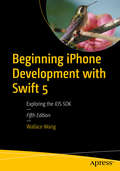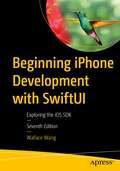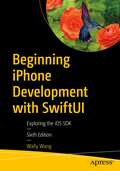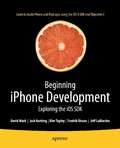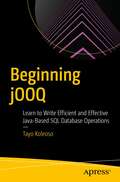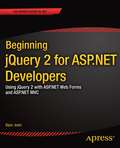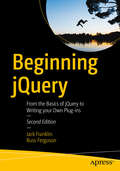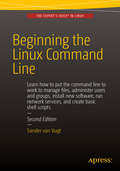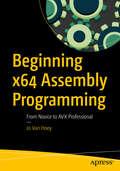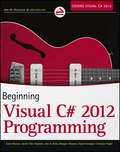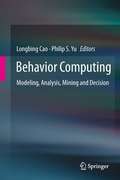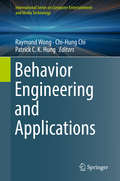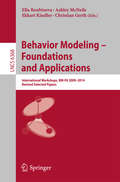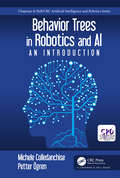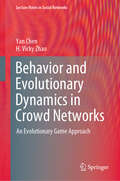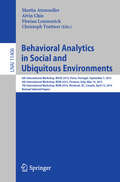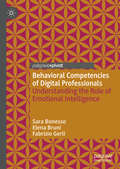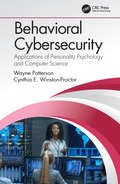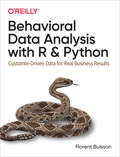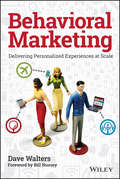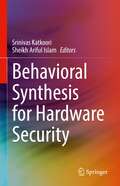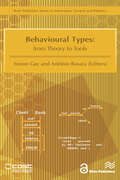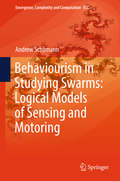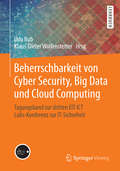- Table View
- List View
Beginning iPhone Development with Swift 5: Exploring the iOS SDK
by Wallace WangLearn how to integrate all the interface elements iOS users have come to know and love, such as buttons, switches, pickers, toolbars, and sliders. In this edition of the best selling book, you’ll also learn about touch gestures, table views, and collection views for displaying data on a user interface. Assuming little or no working knowledge of the Swift programming language, and written in a friendly, easy-to-follow style, this book offers a comprehensive course in iPhone and iPad programming. The book starts with a gentle introduction to using Xcode and then guides you though the creation of your first simple application.You’ll start with designing basic user interfaces and then explore more sophisticated ones that involve multiple screens such as navigation controllers, tab bars, tool bars, page views, and split views that are particularly useful on the larger screens of the iPad and certain iPhone models. And there’s much more! Beginning iPhone Development with Swift 5 covers the basic information you need to get up and running quickly to turn your great ideas into working iOS apps. Once you’re ready, move on to Pro iPhone Development with Swift 5 to learn more of the really unique aspects of iOS programming and the Swift language.What You Will LearnDiscover what data persistence is, and why it’s importantBuild cool, crisp user interfacesDisplay data in Table ViewsWork with all the most commonly used iOS FrameworksWho This Book is ForAspiring iOS app developers new to the Apple Swift programming language and/or the iOS SDK.
Beginning iPhone Development with SwiftUI: Exploring the iOS SDK
by Wallace WangTame the power of Apple’s new user interface toolkit, SwiftUI. This revised and expanded Seventh Edition covers the basic information you need to get up and running quickly to turn your great ideas into working iOS apps with stunningly interactive interfaces using SwiftUI. New chapters cover expandable text fields, multidate pickers, using gauges, progress views and variable SF symbol icons, creating chats, and using the navigation stack and split view.You’ll start with basic designs and then explore more sophisticated ones. Assuming little or no working knowledge of the Swift programming language, and written in a friendly, easy-to-follow style, this book offers a comprehensive course in iPhone and iPad programming. The book provides a gentle introduction to using Xcode and then guides you though the creation of your first simple application. You’ll create user interfaces for that application using multiple screens in two different ways—using Navigation View and Tab Bars.Then integrate all the interface elements iOS users have come to know and love, such as buttons, switches, pickers, toolbars, and sliders with less effort and more efficiency. You’ll also learn about touch gestures, lists, and grids for displaying data on a user interface. And you’ll even go beyond those simple controls to liven up any user interface with simple animation techniques. Spice your designs up with movement, scaling, and resizing, including spring and bounce effects!Once you’re ready, move on to Pro iPhone Development with Swift UI to learn more of the unique aspects of iOS programming and the Swift language. What You Will LearnDiscover the basics of designing a user interface using SwiftUIBuild cool, crisp user interfaces that use animationDisplay data in lists and outlinesOrganize user interfaces in forms and groups Who This Book is For Aspiring iOS app developers new to the Apple Swift programming language and/or the iOS SDK.
Beginning iPhone Development with SwiftUI: Exploring the iOS SDK
by Wally WangTame the power of Apple’s new user interface toolkit, SwiftUI. Integrate all the interface elements iOS users have come to know and love, such as buttons, switches, pickers, toolbars, and sliders with less effort and more efficiency. You’ll also learn about touch gestures, lists, and grids for displaying data on a user interface. And you’ll even go beyond those simple controls to liven up any user interface with simple animation techniques. Spice your designs up with movement, scaling, and resizing, including spring and bounce effects!You’ll start with basic designs and then explore more sophisticated ones. Assuming little or no working knowledge of the Swift programming language, and written in a friendly, easy-to-follow style, this book offers a comprehensive course in iPhone and iPad programming. The book starts with a gentle introduction to using Xcode and then guides you though the creation of your first simple application. You’ll create user interfaces for that application using multiple screens in two different ways—using Navigation View and Tab Bars.Beginning iPhone Development with Swift UI covers the basic information you need to get up and running quickly to turn your great ideas into working iOS apps with stunningly interactive interfaces using SwiftUI. Once you’re ready, move on to Pro iPhone Development with Swift UI to learn more of the unique aspects of iOS programming and the Swift language.What You Will LearnDiscover the basics of designing a user interface using SwiftUIBuild cool, crisp user interfaces that use animationDisplay data in lists and outlinesOrganize user interfaces in forms and groups Who This Book is For Aspiring iOS app developers new to the Apple Swift programming language and/or the iOS SDK.
Beginning iPhone Development: Exploring the iOS SDK
by Kim Topley David Mark Jeff Lamarche Jack Nutting Fredrik OlssonThe authors of the bestselling Beginning iPhone 3 Development are back, with the same excellent material completely updated for iOS 4 and written from the ground up using the latest version of Apple's Xcode 3. All source code has been updated to use the latest Xcode templates and current APIs, and all-new screenshots show Xcode 3 in action. Beginning iPhone 4 Development is a complete course in iOS development. You'll master techniques that work on iPhone, iPad, and iPod touch. We start with the basics, showing you how to download and install the tools you'll need, and how to create your first simple application. Next you'll learn to integrate all the interface elements iOS users have come to know and love, such as buttons, switches, pickers, toolbars, and sliders. You'll master a variety of design patterns, from the simplest single view to complex hierarchical drill-downs. The confusing art of table building will be demystified, and you'll learn techniques to save and retrieve your data using SQLite, iPhone's built-in database management system and Core Data, the standard for persistence that Apple brought to iOS with the release of SDK 3. And there's much more You'll learn to draw using Quartz 2D and OpenGL ES, add multitouch gestural support (pinches and swipes) to your applications, and work with the camera, photo library, accelerometer, and built-in GPS. You'll discover the fine points of application preferences and learn how to localize your apps for multiple languages. You'll also learn how to use the new concurrency APIs included in iOS 4, and make robust multithreaded applications using Grand Central Dispatch. * The iPhone 4 update to the best-selling and most recommended book for Cocoa touch developers * Written in an accessible, easy-to-follow style * Full of useful tips and techniques to help you become an iOS pro What you'll learn * Everything you need to know to develop your own best-selling iPhone and iPad apps * Best practices for optimizing your code and delivering great user experiences * How to create OC universal apps for both iPhone and iPad Who this book is for Anyone who wants to start developing for iPhone, iPad, and iPod touch. You can discover more about this book, download source code, and find support forums at the book's companion site, at www. iphonedevbook. com. Table of Contents * Welcome to the Jungle * Appeasing the Tiki Gods * Handling Basic Interaction * More User Interface Fun * Autorotation and Autosizing * Multiview Applications * Tab Bars and Pickers * Introduction to Table Views * Navigation Controllers and Table Views * iPad Considerations * Application Settings and User Defaults * Basic Data Persistence * Grand Central Dispatch, Background Processing, and You * Drawing with Quartz and OpenGL * Taps, Touches, and Gestures * Where Am I? Finding Your Way with Core Location * Whee Gyro and Accelerometer * iPhone Camera and Photo Library * Application Localization * Where to Next?"
Beginning jOOQ: Learn to Write Efficient and Effective Java-Based SQL Database Operations
by Tayo KoleosoLearn to use the jOOQ library to manage SQL database operations in Java and JVM applications. This book walks you through what JOOQ is, how to install and get started with it, and then gets you working with it. Practical examples and case studies demonstrate how jOOQ offers a more efficient and versatile alternative to Object-Relational Mapping frameworks like Hibernate and JPA, while providing a natural, native-SQL feeling for the developer. You'll see how to maximize the full potential of your SQL database with advanced query syntax and functions with this lightweight, SQL-friendly framework. Come see how you can use high performance approaches like reactive, data streaming and cloud-native programming to get data from SQL tables. Never write another incorrect SQL statement again and protect your application from SQL injection with the strong typing and inbuilt controls in jOOQ. Learn how to add jOOQ to your existing Hibernate, Spring Boot or Quarkus applications. When you’ve completed this book, you will be able to take the knowledge you’ve gained, along with the freely available source code, and directly apply them to your own work. What You Will Learn Comparing equivalent features between Hibernate, JPA and jOOQUnlock the power of your SQL database with high performing, flexible and typesafe SQL queriesSeamlessly work with many different SQL database vendors without changing your codeEffortlessly generate Java code based on the content of your databaseWrite reactive SQL database access code with R2DBCIntegrating jOOQ into popular frameworks and platforms like Hibernate, Spring boot and Quarkus tools like IDEsTesting jOOQ-based code with modern integration testing frameworks like TestContainers and DockerLearn how to safely handle data access code within frameworks like the Java Persistence API (JPA) Who This Book Is For Intermediate Java programmers new to jOOQ. Some prior experience with SQL may be helpful but not required.
Beginning jQuery 2 for ASP.NET Developers: Using jQuery 2 with ASP.NET Web Forms and ASP.NET MVC
by Bipin JoshijQuery is the most popular JavaScript library in use today, appearing on nearly two thirds of the 10,000 most visited sites on the web. With this sort of popularity, it's clear that ASP. NET developers can't afford to miss out. By combining jQuery with ASP. NET you get the best of both worlds: the client-side interactivity and responsiveness of JavaScript with the robustness and extensibility of Microsoft's web stack. Beginning jQuery 2 for ASP. NET Developers shows you how. To begin with, you'll find out how jQuery hooks up with your ASP. NET controls, and simplifies event handling by keeping it in the browser. Then you'll learn to handle dynamic content and responsive layouts by interacting with the DOM. Effects and animations are one of the most popular uses of the jQuery library, so we cover that next--showing you how to get a sleek modern look and feel to your site using some of the vast library of JavaScript that's already out there waiting to be used. Ajax is one of the areas where jQuery really shines, so you'll find out how to make Ajax calls to a web service and get data onto a page without waiting for slow ASP. NET postbacks every time. And no book on jQuery would be complete without jQuery Mobile: the popular mobile web framework that gets you writing sites that work across all the major mobile platforms. What you'll learn Select DOM elements using powerful jQuery selectors Use jQuery with ASP. NET server controls, ASP. NET MVC form fields and other DOM elements Manipulate and traverse the DOM tree and add jQuery effects to ASP. NET web pages Make Ajax calls and pass JSON data to Web Services, Web Methods, WCF services, controller action methods, HTTP handlers and Web APIs Understand code reuse by creating and using jQuery plugins Get introduced to jQuery UI and jQuery mobile and use them in ASP. NET Web Forms and MVC applications Who this book is for This book is for novice to intermediate developers who want to improve and enhance their ASP. NET Web Forms and ASP. NET MVC projects with client-side scripting. Table of Contents Chapter 1. The JavaScript You Need to Know Chapter 2. A First Look at jQuery Chapter 3. ASP. NET Controls and jQuery Selectors Chapter 4. How jQuery Simplifies Event Handling Chapter 5. The DOM and Dynamic Content Chapter 6. More DOM and Useful jQuery Methods Chapter 7. Great-looking ASP. NET Pages with jQuery Effects and Animations Chapter 8. Making Ajax Calls to . NET Web Services Chapter 9. Creating and Using jQuery Plug-ins Chapter 10. jQuery UI and jQuery Mobile Chapter 11. Useful jQuery and ASP. NET Recipes Appendix: Learning Resources
Beginning jQuery: From the Basics of jQuery to Writing your Own Plug-ins
by Russ Ferguson Jack FranklinBeginning jQuery is your step-by-step guide to learning the jQuery library. jQuery is the most popular JavaScript library in the web developer's toolkit. Jack Franklin takes you from the basics of getting you started with jQuery, right through to extending jQuery by writing your own plug-ins. You'll discover best practices you can follow, how you can avoid common mistakes, and you'll learn about so many of the things that jQuery has to offer, including how you can: Use jQuery's powerful tools to dynamically update content on your site, including DOM manipulation. Extend jQuery's capabilities by writing your own plugins on top of the framework. Animate elements and build your own jQuery slider. Employ best practices and avoid common errors made by beginners. JavaScript is a powerful language but every web developer must navigate the tricky issues around cross-browser inconsistencies. Beginning jQuery teaches you how to use jQuery to avoid spending your time fixing these browser bugs - letting you concentrate on what really matters to you. Throughout Beginning jQuery, you'll discover how expressive yet concise jQuery's code is and how much quicker and efficient you can develop with jQuery!
Beginning the Linux Command Line
by Sander VugtThis is Linux for those of us who don't mind typing. All Linux users and administrators tend to like the flexibility and speed of Linux administration from the command line in byte-sized chunks, instead of fairly standard graphical user interfaces. Beginning the Linux Command Line is verified against all of the most important Linux distributions, and follows a task-oriented approach which is distribution agnostic. Now this Second Edition of Beginning the Linux Command Line updates to the very latest versions of the Linux Operating System, including the new Btrfs file system and its management, and systemd boot procedure and firewall management with firewalld! Updated to the latest versions of Linux Work with files and directories, including Btrfs! Administer users and security, and deploy firewalld Understand how Linux is organized, to think Linux! What you'll learn The information in this book is verified against all of the most important Linux distributions Updated to the latest versions of Linux Finding help from in-system resources Finding the right command for the task you have to accomplish Working with text editors and intelligent filters Shell programming Managing partitions and file systems Configuring access to hardware devices Who this book is for Everyone who uses Linux. No exceptions. Table of Contents 1. Starting Linux Command-Line Administration 2. Performing Essential Command-Line Tasks 3. Administering the Linux File System, including Btrfs 4. Working with Text Files 5. Managing Partitions and Logical Volumes 6. Managing Users and Groups 7. Managing Permissions 8. Managing Software 9. Process and System Management 10. System Logging 11. Configuring the Network 12. Configuring the File Server 13. Working with the Kernel 14. Introduction to Bash Shell Scripting A. Installing Linux
Beginning x64 Assembly Programming: From Novice to AVX Professional
by Jo Van HoeyProgram in assembly starting with simple and basic programs, all the way up to AVX programming. By the end of this book, you will be able to write and read assembly code, mix assembly with higher level languages, know what AVX is, and a lot more than that. The code used in Beginning x64 Assembly Programming is kept as simple as possible, which means: no graphical user interfaces or whistles and bells or error checking. Adding all these nice features would distract your attention from the purpose: learning assembly language. The theory is limited to a strict minimum: a little bit on binary numbers, a short presentation of logical operators, and some limited linear algebra. And we stay far away from doing floating point conversions. The assembly code is presented in complete programs, so that you can test them on your computer, play with them, change them, break them. This book will also show you what tools can be used, how to use them, and the potential problems in those tools. It is not the intention to give you a comprehensive course on all of the assembly instructions, which is impossible in one book: look at the size of the Intel Manuals. Instead, the author will give you a taste of the main items, so that you will have an idea about what is going on. If you work through this book, you will acquire the knowledge to investigate certain domains more in detail on your own. The majority of the book is dedicated to assembly on Linux, because it is the easiest platform to learn assembly language. At the end the author provides a number of chapters to get you on your way with assembly on Windows. You will see that once you have Linux assembly under your belt, it is much easier to take on Windows assembly.This book should not be the first book you read on programming, if you have never programmed before, put this book aside for a while and learn some basics of programming with a higher-level language such as C.What You Will LearnDiscover how a CPU and memory worksAppreciate how a computer and operating system work togetherSee how high-level language compilers generate machine language, and use that knowledge to write more efficient codeBe better equipped to analyze bugs in your programsGet your program working, which is the fun partInvestigate malware and take the necessary actions and precautionsWho This Book Is ForProgrammers in high level languages. It is also for systems engineers and security engineers working for malware investigators. Required knowledge: Linux, Windows, virtualization, and higher level programming languages (preferably C or C++).
Beginning: Visual C#® 2012 Programming
by Christian Nagel Karli Watson Morgan Skinner Jacob Vibe Hammer John D. Reid Daniel KemperStep-by-step beginner's guide to Visual C# 2012 Written for novice programmers who want to learn programming with C# and the . NET framework, this book offers programming basics such as variables, flow control, and object oriented programming. It then moves into web and Windows programming and data access (databases and XML). The authors focus on the tool that beginners use most often to program C#, the Visual C# 2012 development environment in Visual Studio 2012. Puts the spotlight on key beginning level topics with easy-to-follow instructions for Microsoft Visual C# 2012 Explores how to program for variables, expressions, flow control, and functions Explains the debugging process and error handling as well as object oriented programming, and much more Beginning Microsoft Visual C# 2012 Programming offers beginners a guide to writing effective programming code following simple step-by-step methods, each followed by the opportunity to try out newly acquired skills.
Behavior Computing: Modeling, Analysis, Mining and Decision (Lecture Notes in Computer Science #8178)
by Philip S. Yu Longbing Cao'Behavior' is an increasingly important concept in the scientific, societal, economic, cultural, political, military, living and virtual worlds. Behavior computing, or behavior informatics, consists of methodologies, techniques and practical tools for examining and interpreting behaviours in these various worlds. Behavior computing contributes to the in-depth understanding, discovery, applications and management of behavior intelligence. With contributions from leading researchers in this emerging field Behavior Computing: Modeling, Analysis, Mining and Decision includes chapters on: representation and modeling behaviors; behavior ontology; behaviour analysis; behaviour pattern mining; clustering complex behaviors; classification of complex behaviors; behaviour impact analysis; social behaviour analysis; organizational behaviour analysis; and behaviour computing applications. Behavior Computing: Modeling, Analysis, Mining and Decision provides a dedicated source of reference for the theory and applications of behavior informatics and behavior computing. Researchers, research students and practitioners in behavior studies, including computer science, behavioral science, and social science communities will find this state of the art volume invaluable.
Behavior Engineering and Applications (International Series on Computer Entertainment and Media Technology)
by Chi-Hung Chi Raymond Wong Patrick C. HungMany industrial applications built today are increasingly using emerging behavior engineering technologies: this book looks at various research and practical issues for researchers and students working in computer science and engineering, and for industry technology providers interested in behavior engineering and applications. Behavior Engineering and Applications encompasses intelligent and efficient computational solutions, including models, architectures, algorithms and specific applications, focused on processing, discovering, understanding and analyzing the behavior captured by the above data. Focusing on applying any engineering paradigm to systemically process, discover, understand and analyze these data, this book also addresses problems in a variety of areas and applications that related to behavior engineering.This book includes chapters derived from selected papers from The 2016 International Conference on Behavior Engineering (ICBE), as well as separate contributions the editors selected cutting-edge research related to behavior engineering.
Behavior Modeling -- Foundations and Applications: International Workshops, BM-FA 2009-2014, Revised Selected Papers (Lecture Notes in Computer Science #6368)
by Ella Roubtsova Ashley Mcneile Ekkart Kindler Christian GerthThis book constitutes revised selected papers from the six International Workshops on Behavior Modelling - Foundations and Applications, BM-FA, which took place annually between 2009 and 2014. The 9 papers presented in this volume were carefully reviewed and selected from a total of 58 papers presented at these 6 workshops. The contributions were organized in topical sections named: modelling practices; new ways of behaviour modelling: events in modelling; and new ways of behaviour modelling: protocol modelling.
Behavior Trees in Robotics and AI: An Introduction (Chapman & Hall/CRC Artificial Intelligence and Robotics Series)
by Michele Colledanchise Petter ÖgrenBehavior Trees (BTs) provide a way to structure the behavior of an artificial agent such as a robot or a non-player character in a computer game. Traditional design methods, such as finite state machines, are known to produce brittle behaviors when complexity increases, making it very hard to add features without breaking existing functionality. BTs were created to address this very problem, and enables the creation of systems that are both modular and reactive. Behavior Trees in Robotics and AI: An Introduction provides a broad introduction as well as an in-depth exploration of the topic, and is the first comprehensive book on the use of BTs. <P><P> This book introduces the subject of BTs from simple topics, such as semantics and design principles, to complex topics, such as learning and task planning. For each topic, the authors provide a set of examples, ranging from simple illustrations to realistic complex behaviors, to enable the reader to successfully combine theory with practice. <P><P> Starting with an introduction to BTs, the book then describes how BTs relate to, and in many cases, generalize earlier switching structures, or control architectures. These ideas are then used as a foundation for a set of efficient and easy to use design principles. The book then presents a set of important extensions and provides a set of tools for formally analyzing these extensions using a state space formulation of BTs. <P><P> With the new analysis tools, the book then formalizes the descriptions of how BTs generalize earlier approaches and shows how BTs can be automatically generated using planning and learning. The final part of the book provides an extended set of tools to capture the behavior of Stochastic BTs, where the outcomes of actions are described by probabilities. These tools enable the computation of both success probabilities and time to completion. <P><P> This book targets a broad audience, including both students and professionals interested in modeling complex behaviors for robots, game characters, or other AI agents. Readers can choose at which depth and pace they want to learn the subject, depending on their needs and background.
Behavior and Evolutionary Dynamics in Crowd Networks: An Evolutionary Game Approach (Lecture Notes in Social Networks)
by Yan Chen H. Vicky ZhaoThis book offers a holistic framework to study behavior and evolutionary dynamics in large-scale, decentralized, and heterogeneous crowd networks. In the emerging crowd cyber-ecosystems, millions of deeply connected individuals, smart devices, government agencies, and enterprises actively interact with each other and influence each other’s decisions. It is crucial to understand such intelligent entities’ behaviors and to study their strategic interactions in order to provide important guidelines on the design of reliable networks capable of predicting and preventing detrimental events with negative impacts on our society and economy.This book reviews the fundamental methodologies to study user interactions and evolutionary dynamics in crowd networks and discusses recent advances in this emerging interdisciplinary research field. Using information diffusion over social networks as an example, it presents a thorough investigation of the impact of user behavior on the network evolution process and demonstrates how this can help improve network performance.Intended for graduate students and researchers from various disciplines, including but not limited to, data science, networking, signal processing, complex systems, and economics, the book encourages researchers in related research fields to explore the many untouched areas in this domain, and ultimately to design crowd networks with efficient, effective, and reliable services.
Behavioral Analytics in Social and Ubiquitous Environments: 6th International Workshop on Mining Ubiquitous and Social Environments, MUSE 2015, Porto, Portugal, September 7, 2015; 6th International Workshop on Modeling Social Media, MSM 2015, Florence, Italy, May 19, 2015; 7th International Workshop on Modeling Social Media, MSM 2016, Montreal, QC, Canada, April 12, 2016; Revised Selected Papers (Lecture Notes in Computer Science #11406)
by Martin Atzmueller Alvin Chin Christoph Trattner Florian LemmerichThe 7 papers presented in this book are revised and significantly extended versions of papers submitted to three related workshops: 6th International Workshop on Mining Ubiquitous and Social Environments, MUSE 2015, held in Porto, Portugal, September 2015, in conjunction with the 6th European Conference on Machine Learning and Principles and Practice of Knowledge Discovery in Databases, ECML-PKDD 2015; 6th International Workshop on Modeling Social Media, MSM 2015, held in Florence, Italy, May 2015, in conjunction with the 24th International World Wide Web Conference, WWW 2015; 7th International Workshop on Modeling Social Media, MSM 2016, Montreal, QC, Canada, April 2016, in conjunction with the 25th International World Wide Web Conference, WWW 2016.
Behavioral Competencies of Digital Professionals: Understanding the Role of Emotional Intelligence
by Sara Bonesso Elena Bruni Fabrizio Gerli‘I encounter many data scientists and analysts whose sole focus is solving analytical problems and developing accurate models. They all need to read this excellent book and adopt its recommendations!’. — Thomas H. Davenport, Distinguished Professor, Babson College, Research Fellow, MIT Initiative on the Digital Economy ‘This book provides a compelling, credible and sound narrative to de-code complexity by developing a set of competencies (action, social, awareness, cognitive, exploration and organizational) supported by emotional intelligence. A must read for Leaders and HR practitioners, for the intellectual curious eager to understand that Human Beings will have to remain central to Human Development’. —Paolo Gallo, Former CHRO at World Economic Forum, World Bank and European BankShedding new light on the human side of big data through the lenses of emotional and social intelligence competencies, this book advances the understanding of the requirements of the different professions that deal with big data. It also illustrates the empirical evidence collected through the application of the competency-based methodology to a sample of data scientists and data analysts, the two most in-demand big data jobs in the labor market. The book provides recommendations for the higher education system to offer better designed curricula for entry-level big data professions. It also offers managerial insights in describing how organizations and specifically HR practitioners can benefit from the competency-based approach to overcome the skill shortage that characterizes the demand for big data professional roles and to increase the effectiveness of the selection and recruiting processes.
Behavioral Cybersecurity: Applications of Personality Psychology and Computer Science
by Wayne Patterson Cynthia E. Winston-ProctorSince the introduction and proliferation of the Internet, problems involved with maintaining cybersecurity has grown exponentially, and have evolved into many forms of exploitation. Yet, Cybersecurity has had far too little study and research. Virtually all of the Research that has taken place in cybersecurity over many years, has been done by those with computer science, electrical engineering, and mathematics backgrounds. However, many cybersecurity researchers have come to realize that to gain a full understanding of how to protect a cyber environment requires not only the knowledge of those researchers in computer science, engineering and mathematics, but those who have a deeper understanding of human behavior: researchers with expertise in the various branches of behavioral science, such as psychology, behavioral economics, and other aspects of brain science. The authors, one a computer scientist and the other a psychologist, have attempted over the past several years to understand the contributions that each approach to cybersecurity problems can benefit from this integrated approach that we have tended to call "behavioral cybersecurity." The authors believe that the research and curriculum approaches developed from this integrated approach provide a first book with this approach to cybersecurity. This book incorporates traditional technical computational and analytic approaches to cybersecurity, and also psychological and human factors approaches, as well. Features Discusses profiling approaches and risk management Includes case studies of major cybersecurity events and "Fake News" Presents analyses of password attacks and defenses Addresses game theory, behavioral economics and their application to cybersecurity Supplies research into attacker/defender personality and motivation traits Techniques for measuring cyber attacks/defenses using crypto and stego
Behavioral Cybersecurity: Fundamental Principles and Applications of Personality Psychology
by Wayne Patterson Cynthia E. Winston-ProctorThis book discusses the role of human personality in the study of behavioral cybersecurity for non-specialists. Since the introduction and proliferation of the Internet, cybersecurity maintenance issues have grown exponentially. The importance of behavioral cybersecurity has recently been amplified by current events, such as misinformation and cyber-attacks related to election interference in the United States and internationally. More recently, similar issues have occurred in the context of the COVID-19 pandemic. The book presents profiling approaches, offers case studies of major cybersecurity events and provides analysis of password attacks and defenses. Discussing psychological methods used to assess behavioral cybersecurity, alongside risk management, the book also describes game theory and its applications, explores the role of cryptology and steganography in attack and defense scenarios and brings the reader up to date with current research into motivation and attacker/defender personality traits. Written for practitioners in the field, alongside nonspecialists with little prior knowledge of cybersecurity, computer science, or psychology, the book will be of interest to all who need to protect their computing environment from cyber-attacks. The book also provides source materials for courses in this growing area of behavioral cybersecurity.
Behavioral Data Analysis with R and Python: Customer-driven Data For Real Business Results
by Florent BuissonHarness the full power of the behavioral data in your company by learning tools specifically designed for behavioral data analysis. Common data science algorithms and predictive analytics tools treat customer behavioral data, such as clicks on a website or purchases in a supermarket, the same as any other data. Instead, this practical guide introduces powerful methods specifically tailored for behavioral data analysis.Advanced experimental design helps you get the most out of your A/B tests, while causal diagrams allow you to tease out the causes of behaviors even when you can't run experiments. Written in an accessible style for data scientists, business analysts, and behavioral scientists, thispractical book provides complete examples and exercises in R and Python to help you gain more insight from your data--immediately.Understand the specifics of behavioral dataExplore the differences between measurement and predictionLearn how to clean and prepare behavioral dataDesign and analyze experiments to drive optimal business decisionsUse behavioral data to understand and measure cause and effectSegment customers in a transparent and insightful way
Behavioral Marketing: Delivering Personalized Experiences at Scale
by Dave WaltersGrow revenue by leveraging behavioral marketing during your next campaign Behavioral Marketing guides you in using relatively new marketing tactics to grow revenue and create process efficiencies. An incredibly valuable text, this book defines the key principles of behavioral marketing—including customer journey mapping, channel-level planning, data capture and hygiene, campaign creation, delivery best practices, and measurement/optimization—and shows you how to fix highly inefficient processes while implementing your next marketing initiative. Within the pages of this resource are the secrets to improving processes and becoming more 'revenue predictable'—things that benefit businesses in virtually any industry. Additionally, this book provides you with case studies that spotlight the successes and challenges experienced by other marketing pros, and offer up key lessons to assist you in sharing their triumphs and avoiding their pitfalls. Behavioral marketing, a term first coined in 2008, has become increasingly important as digital marketing tactics have becoming increasingly popular. This particular facet of marketing focuses on responding to the actions, clicks, and behaviors of both current and prospective customers—and allows you to use this data to adapt your marketing efforts to customer preferences. The results of this dynamic marketing approach are often a more predictable revenue stream and a more efficient marketing department, both of which any business would welcome! Understand the key principles of behavioral marketing Create a more 'revenue predictable' business environment Examine case studies across multiple industries Discover how to achieve revenue growth and process efficiencies with the right behavioral marketing tactics Behavioral Marketing is a unique resource that brings value and insight to all marketing professionals using digital marketing tactics.
Behavioral Synthesis for Hardware Security
by Srinivas Katkoori Sheikh Ariful IslamThis book presents state-of-the-art research results from leading electronic design automation (EDA) researchers on automated approaches for generating cyber-secure, smart hardware. The authors first provide brief background on high-level synthesis principles and motivate the need for secure design during behavioral synthesis. Then they provide readers with synthesis techniques for six automated security solutions, namely, hardware obfuscation, hardware Trojan detection, IP watermarking, state encoding, side channel attack resistance, and information flow tracking.Provides a single-source reference to behavioral synthesis for hardware security;Describes automatic synthesis techniques for algorithmic obfuscation, using code transformations;Includes behavioral synthesis techniques for intellectual property protection.
Behavioural Types: From Theory to Tools
by António Ravara Simon GayBehavioural type systems in programming languages support the specification and verification of properties of programs beyond the traditional use of type systems to describe data processing. A major example of such a property is correctness of communication in concurrent and distributed systems, motivated by the importance of structured communication in modern software. Behavioural Types: from Theory to Tools presents programming languages and software tools produced by members of COST Action IC1201: Behavioural Types for Reliable Large-Scale Software Systems, a European research network that was funded from October 2012 to October 2016. As a survey of the most recent developments in the application of behavioural type systems, it is a valuable reference for researchers in the field, as well as an introduction to the area for graduate students and software developers.
Behaviourism in Studying Swarms: Logical Models of Sensing and Motoring (Emergence, Complexity And Computation Ser. #33)
by Andrew SchumannThis book presents fundamental theoretical results for designing object-oriented programming languages for controlling swarms. It studies the logics of swarm behaviours. According to behaviourism, all behaviours can be controlled or even managed by stimuli in the environment: attractants (motivational reinforcement) and repellents (motivational punishment). At the same time, there are two main stages in reactions to stimuli: sensing (perceiving signals) and motoring (appropriate direct reactions to signals). This book examines the strict limits of behaviourism from the point of view of symbolic logic and algebraic mathematics: how far can animal behaviours be controlled by the topology of stimuli? On the one hand, we can try to design reversible logic gates in which the number of inputs is the same as the number of outputs. In this case, the behaviouristic stimuli are inputs in swarm computing and appropriate reactions at the motoring stage are its outputs. On the other hand, the problem is that even at the sensing stage each unicellular organism can be regarded as a logic gate in which the number of outputs (means of perceiving signals) greatly exceeds the number of inputs (signals).
Beherrschbarkeit von Cyber Security, Big Data und Cloud Computing: Tagungsband zur dritten EIT ICT Labs-Konferenz zur IT-Sicherheit
by Klaus-Dieter Wolfenstetter Udo BubCloud Computing, Big Data, Cyber Security, Industrie 4. 0 etc. sind vielleicht nur Schlagworte, aber sie sind auch Ausdruck neuer, komplexer Problemstellungen, deren Behandlung und Beherrschung uns vor große Herausforderungen stellt. Deshalb sind wieder einmal, diesmal auf Einladung der EIT ICT Labs in Berlin, renommierte Sicherheitsexperten und Entscheidungsträger zusammen gekommen, um diese Themen zu diskutieren und beleuchten. Durch die Mitte 2013 bekannt gewordenen umfassenden Ausspähungen von Bürgern und Institutionen hat das Konferenzthema Beherrschbarkeit von Cloud und Co. weiter an Aktualität gewonnen.
